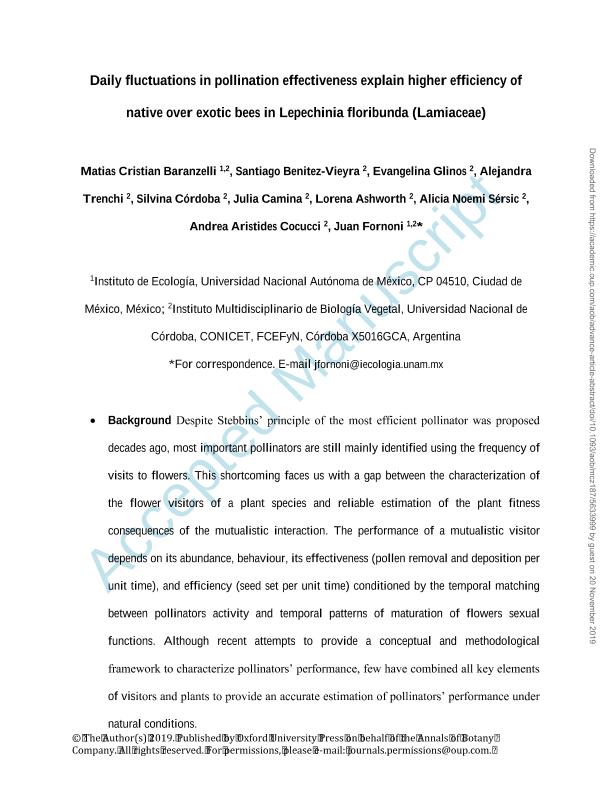Artículo
Daily fluctuations in pollination effectiveness explain higher efficiency of native over exotic bees in Lepechinia floribunda (Lamiaceae)
Baranzelli, Matias Cristian ; Benitez-Vieyra, Santiago Miguel
; Benitez-Vieyra, Santiago Miguel ; Glinos, Evangelina
; Glinos, Evangelina ; Trenchi, Alejandra
; Trenchi, Alejandra ; Córdoba, Silvina Alejandra
; Córdoba, Silvina Alejandra ; Camina, Julia Laura
; Camina, Julia Laura ; Ashworth, Lorena
; Ashworth, Lorena ; Sersic, Alicia Noemi
; Sersic, Alicia Noemi ; Cocucci, Andrea Aristides
; Cocucci, Andrea Aristides ; Fornoni, Juan Enrique
; Fornoni, Juan Enrique
 ; Benitez-Vieyra, Santiago Miguel
; Benitez-Vieyra, Santiago Miguel ; Glinos, Evangelina
; Glinos, Evangelina ; Trenchi, Alejandra
; Trenchi, Alejandra ; Córdoba, Silvina Alejandra
; Córdoba, Silvina Alejandra ; Camina, Julia Laura
; Camina, Julia Laura ; Ashworth, Lorena
; Ashworth, Lorena ; Sersic, Alicia Noemi
; Sersic, Alicia Noemi ; Cocucci, Andrea Aristides
; Cocucci, Andrea Aristides ; Fornoni, Juan Enrique
; Fornoni, Juan Enrique
Fecha de publicación:
12/2019
Editorial:
Oxford University Press
Revista:
Annals of Botany
ISSN:
0305-7364
e-ISSN:
1095-8290
Idioma:
Inglés
Tipo de recurso:
Artículo publicado
Clasificación temática:
Resumen
Despite Stebbins’ principle of the most efficient pollinator being proposed decades ago, the most important pollinators are still mainly identified using the frequency of visits to flowers. This shortcoming results in a gap between the characterization of the flower visitors of a plant species and a reliable estimation of the plant fitness consequences of the mutualistic interaction. The performance of a mutualistic visitor depends on its abundance, behaviour, effectiveness (pollen removal and deposition per unit time) and efficiency (seed set per unit time) conditioned by the temporal matching between pollinator activity and temporal patterns of maturation of the sexual functions of flowers. Although there have been recent attempts to provide a conceptual and methodological framework to characterize pollinators’ performance, few have combined all key elements of visitors and plants to provide an accurate estimation of pollinators’ performance under natural conditions.
Archivos asociados
Licencia
Identificadores
Colecciones
Articulos(IMBIV)
Articulos de INST.MULTIDISCIPL.DE BIOLOGIA VEGETAL (P)
Articulos de INST.MULTIDISCIPL.DE BIOLOGIA VEGETAL (P)
Citación
Baranzelli, Matias Cristian; Benitez-Vieyra, Santiago Miguel; Glinos, Evangelina; Trenchi, Alejandra; Córdoba, Silvina Alejandra; et al.; Daily fluctuations in pollination effectiveness explain higher efficiency of native over exotic bees in Lepechinia floribunda (Lamiaceae); Oxford University Press; Annals of Botany; 125; 3; 12-2019; 509-520
Compartir
Altmétricas



